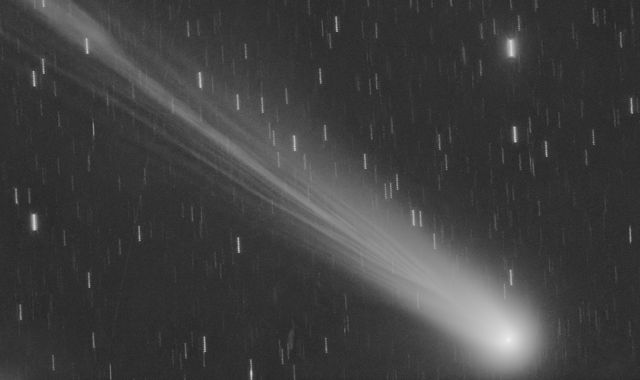
Skygazers in the UK have the best chance this week to see a comet which will not make another close approach to Earth for another 1,300 years, astronomers have said.
Comet Lemmon should be easy to see with binoculars during the evening after sunset - but experts said it may also be possible to see it with the naked eye depending on the weather and if "you've got a very dark sky".
The comet, which orbits the sun, was first detected in January and has been monitored by astronomers during the year.
It came closest to the Earth on Tuesday when it was 56 million miles (90 million km) away, but is still expected to offer people the chance of "something to go and enjoy" into the opening days of November.
Another comet, Swan, came to within 24 million miles (39 million km) of Earth on Tuesday, but it is easier to view from the southern hemisphere with a telescope.
It comes as one of the most reliable meteor showers is set to peak this week when debris left by Halley's Comet will streak across the night sky.
The Orionid meteor shower presents a dramatic light show for UK astronomers, producing up to 20 meteors every hour until the early morning.
Read more:
Here's how to see the Orionid shower
Find out the weather for your area
Best time to see Comet Lemmon
People in the UK are being advised that 8pm is around the best time to see Lemmon, which last made its closest approach to Earth around 1,300 years ago.
By looking at a clear western sky around an hour after sunset, the comet - a greenish cosmic snowball - will appear relatively high and will brighten as it gets nearer to the sun in the coming weeks.
Dr Robert Massey, deputy executive director of the Royal Astronomical Society, said it may be a "little tough" to see with the naked eye, but it should be "reasonably bright" and easy to spot with binoculars.
"Comet Lemmon is pretty much at its best visibility right now," he said.
"The best place to look is in the evening sky. As the sky darkens the comet will first of all be moving, over a matter of days, past the bright star Arcturus, and then further round towards the southwest.
"It will stand out as a fairly bright, fuzzy object.
"The fact that you can see it easily with binoculars makes it fairly unusual, and I think for that reason alone it's something to go and enjoy, particularly if you've never seen a comet before."
This month also brought the chance to see the harvest moon - the first of three consecutive supermoons due to appear before the end of 2025.
Supermoons appear larger and fuller than usual because the moon is at a point in its orbit which is nearer to Earth.
The next supermoon will rise on 5 November and is set to be "the biggest one of all".

(c) Sky News 2025: Comet Lemmon visible in UK after closest approach to Earth in 1,300 years


 Boy, 15, who murdered Harvey Willgoose sentenced to life with minimum term of 16 years
Boy, 15, who murdered Harvey Willgoose sentenced to life with minimum term of 16 years
 Baby P's mother Tracey Connelly tells parole board she allowed partner to abuse her son because she wanted her 'Prince Charming'
Baby P's mother Tracey Connelly tells parole board she allowed partner to abuse her son because she wanted her 'Prince Charming'
 No charges over images of Trump and Epstein projected onto Windsor Castle during president's visit
No charges over images of Trump and Epstein projected onto Windsor Castle during president's visit
 'Man deported under 'one in, one out' scheme returns to UK in small boat
'Man deported under 'one in, one out' scheme returns to UK in small boat



